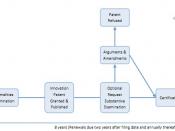Introduction
Technological development and technological innovation exercise an increasingly important influence on firms and their success. Regardless of the industry sector, no firm can today ignore technological trends, if they wish to remain competitive and succeed in the long term. It is therefore important for managers to understand the dynamics of innovation and technological development, as well as the implications of these for the design and implementation of firm-level competitive strategies.
The three basic sources of growth in any economy are growth in inputs of production,
improvements in the efficiency of allocation of inputs across economic activities, and
innovation that generates new products, new uses for existing products and brings about
increases in the efficiently of use inputs 1 . Solow's (1957) path-breaking analysis of growth
in the US economy during the first half of the twentieth century showed that the contribution
of growth in inputs of production, namely labour and capital to aggregate growth, was around
half, and the remaining half, that is the unexplained Solow residual, is commonly attributed
to technical progress or the contribution of innovation in the sense I have used the term.
Since by definition the residual growth is the difference between aggregate growth and the
contributions of growth in factors of production; it is also called Total Factor Productivity
growth or TFP growth. Whether or not TFP growth accounts for a similarly large share of
output in East Asian economics of Korea, Singapore, and Taiwan has been debated (Young
(1992, 1995) and Lau and Kim(1994)), in part on methodological grounds (for example, the
dependence of estimates on essentially arbitrary assumptions about scale economies andfunctional forms for the aggregate production function) and in part on grounds of possible errors of measurement and biases in the data (Pack, 2001).An alternative to the induced innovation model...


